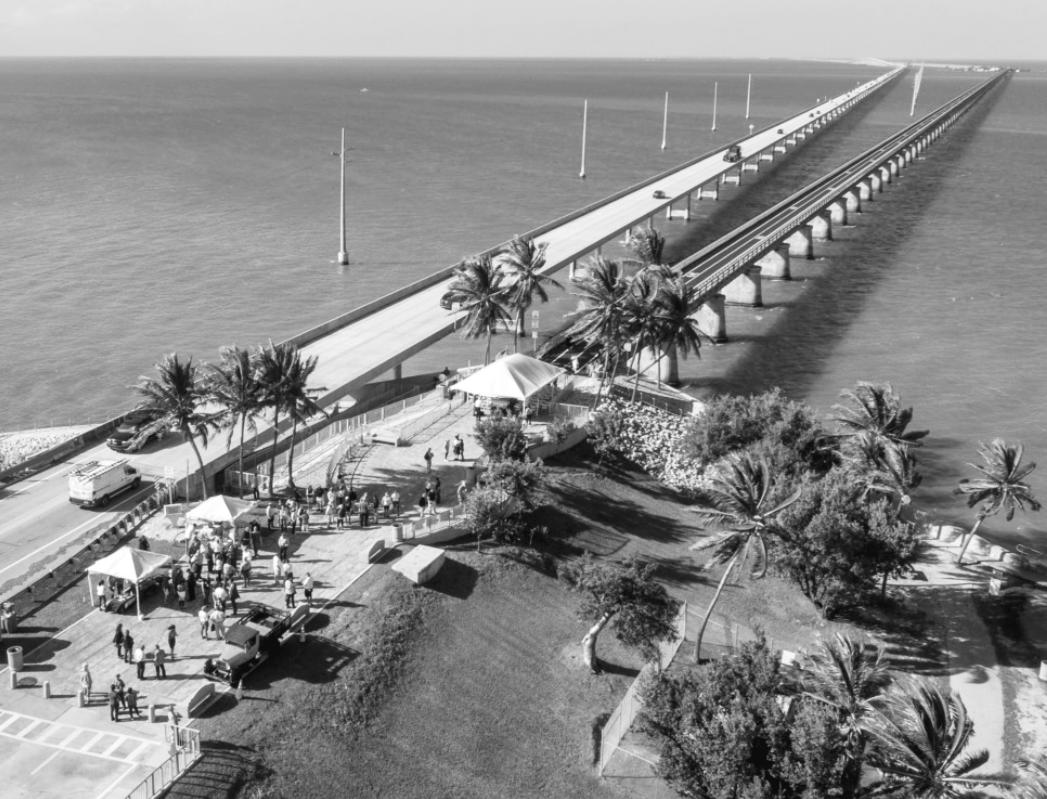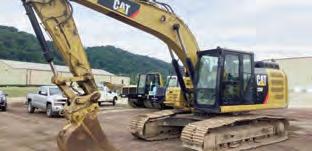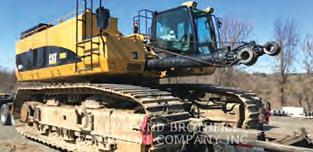
6 minute read
Fla. Keys Celebrates Restoration of Old Seven-Mile Bridge
In one of the most highly anticipated openings in recent Florida Keys history, officials from Monroe County on Jan. 12 gathered with the city of Marathon, the Florida Department of Transportation (FDOT), the Pigeon Key Foundation and Friends of Old Seven to officially welcome the public back to the renovated Old Seven Mile Bridge.
The reestablishment of the 2.2-mi.-long bridge, closed since July 2016, marks the early completion of a massive renovation project. The 30-year restoration and maintenance programs were budgeted at $77 million, $43 million of which was spent to complete the current repairs.
The Old Seven Mile Bridge, right off the Overseas Highway (U.S. Highway 1) at Mile Marker 47, is rich in history. And the views of the Atlantic Ocean and the Gulf of Mexico are beyond breathtaking.
“This bridge is recognized worldwide,” Monroe County Mayor David Rice told the Miami Herald. “There are so many people throughout the country and across the world who are going to be pleased when they find out once again, they can walk the Old Seven Mile Bridge. It has been a while.”
Elements, Time Crippled Old Bridge
FDOT closed the bridge to auto traffic in 2008 as the structure began to crumble. A few years later, citing dangers caused by excess weight, the state agency closed it to fishing, too. After that, the Miami Herald reported, only pedestrians, bicyclists and skaters were allowed on it.
It was completely shuttered in 2016, by which time the Old Seven had severe problems, including decks falling apart and heavy rust that was breaking the railings.
The restoration work included structural steel and concrete repairs, along with new decking and pedestrian handrails. In addition, the path is now freshly paved and painted.
Rehabilitation of the bridge — once called the “eighth wonder of the world” — also included three coats of paint for a rust barrier, primer and topcoat, replacement of thousands of rusted metal plates and rivets, and the installation of a new aluminum rail system, Keys Weekly noted in a Jan. 13 report. To ensure structural integrity, hydraulic jacks were used to lift 10-ft. sections of the bridge, cut out the original Ibeams, originally placed in 1936, and install brand new beams manufactured on site.
“I am absolutely elated,” said Bernard Spinrad, board president of Friends of Old Seven, the organization that united to lead the charge and save the old bridge. In thanking the county, the city of Marathon, and the FDOT, Spinrad noted the “successful public-private partnership, the fruits of which we witness today.”
Old Seven Has Long, Colorful Past
Just like the name states, the bridge is the predecessor to the current Seven Mile Bridge, which opened in 1982 as a smoother, far wider and higher replacement. A 2.2-mi. span of the retired Old Seven links Marathon and Pigeon Key, a tiny island tucked beneath the old bridge that was once home to about 400 workers who built the railroad.
The two Seven Mile bridges run alongside each other in Marathon.
The first bridge was completed in 1912 for the Key West extension of Henry Flagler’s Florida East Coast Railway. It was converted to automobile use in 1938, three years after the powerful Labor Day hurricane of 1935 wiped out the Keys section of the railroad.
The bridge also is a movie star, most famous for its role in the 1994 Arnold Schwarzenegger blockbuster “True Lies,” and the 1989 James Bond film, “License to Kill.”
And the gap in the old bridge, obviously making it off limits to cars these days, the Herald noted, is where for decades a boxy, blue swing span allowed boaters to pass from the Atlantic to the Gulf of Mexico through the narrow Moser Channel.
Numbers Tell Bridge’s True Size
To understand the enormous scope of Old Seven’s renovation, FDOT provided the following approximate numbers to Keys Weekly regarding material costs and labor statistics: • The number of days that the bridge was closed between July 5, 2016, and its Jan. 12, 2022, reopening was 2,017. • A total of 15,000 gallons of polyurethane epoxy and color were used to paint the outside of the bridge. The restored structure’s official color is
Federal Standard 15187, also referred to as “Federal Blue.” • The amount of aluminum railing used to line both sides of the bridge totaled 20,960 linear ft. • The weight of the steel for Old Seven’s
I-beams and panels during the renovation came to 2,586,190 lbs. • As many as 1,100, 10-ft. sections of the bridge were raised to replace I-beams and other compromised support structures underneath. • The weight of each of those raised sections was a hefty 36,000 lbs. • Roughly 700,000-man-hours were devoted to upgrading the bridge to modern standards. Also, FDOT figured that if one worker labored 24/7, the project would have taken 79.9 years to complete. • As many as 80 construction crew members worked on the bridge restoration on any given day. • The budget allowed $7,292 per linear ft. of bridge for repairs and maintenance throughout the project’s duration. • The final cost of the initial construction phase of the project was $43,015,550.






CLEVELAND BROTHER RS USED EQUIPMENT


















2016 CATERPILLAR 966M XE
$198,450 6,345 HRS ID# UP19277

2017 CATERPILLAR D6TVP
$270,000 2,523 HRS ID# UP19508
2018 Caterpillar 966M

$335,000 2,426 HRS ID# UP18901

2011 CATERPILLAR D6T
$257,250 3062 HRS ID# UP19430
2015 Caterpillar 326F

$165,000 2,706 HRS ID# UP19499

2012 Caterpillar 390DL
$410,000 13,490 HRS ID# UT16949
2015 Caterpillar 335FLCR

$235,000 2,777 HRS ID# UP17104


2017 Caterpillar CS66B
$139,000 974 HRS ID# UP19055


